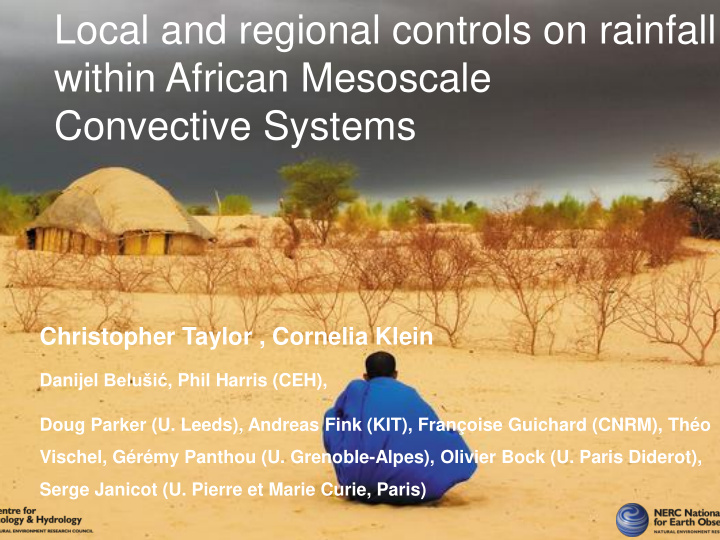



Local and regional controls on rainfall within African Mesoscale Convective Systems Christopher Taylor , Cornelia Klein Danijel Belušić , Phil Harris (CEH), Doug Parker (U. Leeds), Andreas Fink (KIT), Françoise Guichard (CNRM), Théo Vischel, Gérémy Panthou (U. Grenoble-Alpes), Olivier Bock (U. Paris Diderot), Serge Janicot (U. Pierre et Marie Curie, Paris)
Intense rainfall in West Africa AMMA-2050 project working with decision-makers in W Africa to provide robust climate information on 5-40 year time scale Strong demand for more knowledge on flooding, intense rain and links to climate change 1. Has it been changing, and if so why? Ouagadougou 2009 2. What does this suggest about Engel et al, J.Hydro. Met.2017, the future? Lafore et al, QJRMS 2017 3. Does land surface state affect rainfall intensity?
1. Is intense rainfall changing in Sahel? Rain gauge network shows storms getting more intense since the 1970/80s drought. Cloud-top temperatures from the Ouagadougou storm Long-term Meteosat satellite record: • Sub-hourly cloud-top temperatures since 1982 • Mesoscale Convective Systems (MCS) produce ~90% of Sahel rain • Readily identified as large, cold Panthou et al, I.J.Clim. 2014 systems Mathon et al, J Appl. Met. 2002
Can we use Meteosat to look at extreme Sahelian rainfall? Contribution Yes…85% of extreme daily gauge (%) per quintile totals associated with large (>25,000 km 2 ), cold (<-40 ° C) systems (mm/hour) in MCS from Maximum rainfall Likelihood of extreme rain within MCS rises with decreasing T TRMM PR Mean MCS Temperature (°C) from Meteosat Data from 1640 coincident overpasses Taylor et al, Nature 2017 Klein et al, JGR-Atmos 2018
Evolution of MCS properties over 35 years Period 1982-2016 covers 9 Meteosat satellites, including First (MFG) and Second (MSG) Generations. Number of MCS at threshold of -40 ° C well-correlated with seasonal rainfall (r=0.88) More linear increase at lower threshold (-70 ° C). Well-correlated to global mean temperature Cross-calibrated Climate Data Record (GridSat) confirms trend in cold system frequency MCSs getting colder Taylor et al, Nature 2017
Why is rainfall intensity changing? Sahelian boundary layer hasn’t been getting warmer or moister during wet season since 1980s GPS measurements of precipitable water relative to MCS arrival time At event time scale, there is no correlation between More intense Rapid rise in PW ahead of MCS MCS: more MCS “intensity” (cloud -top rapid rise just temperature) and pre- ahead of MCS event moisture (6 hours ahead). But correlations with intensity do exist for zonal wind shear and mid-level dryness Taylor et al, Nature 2017
Warming trends across Africa Recent JJAS temperature trends (°C/decade) Synoptic stations ERA-Interim MSU lower Historical CMIP5 troposphere simulations Evolution of meridional temperature difference in CMIP5 GCMs Taylor et al, Nature 2017 Cook and Vizy, J Clim 2015, Zhou, Sci. Rep. 2016 Warmer Sahara: increased shear, warmer Saharan Air Layer with lower RH, and (in principle) impact on easterly waves
2.What does this suggest about the future? Whatever else happens to West African Monsoon, expect meridional temperature gradient to continue to increase Impact on MCSs (via shear, mid-level RH decreases, easterly waves?) expected to continue to produce strong intensification – effects (largely) not captured by GCMs Temperature trends Intense MCS trends Similar processes may also already be influencing convection in pre-monsoon months further south March-April-May
3. Does land surface state affect rainfall intensity? We know from previous studies in Sahel that MCS initiation is favoured in regions with mesoscale heterogeneity (soil moisture, wetlands, forest cover…) Can land surface also affect convection within mature MCSs? Taylor et al., Nat. Geosci. 2011, Garcia- Carreras et al, JGR-Atmos 2010, Taylor et al, QJRMS 2018
At scale of MCS (25,000+km 2 )… Composite evening MCS at Niamey (box): differences between days with coldest and warmest quartile events More intense MCSs tend to occur over drier soils Indicative of feedback on MCS intensity AMSR-E soil moisture differences [% volumetric]; Dashed line: 95% significance between intense and weak MCSs Contours and vectors: ERA-I Temp [K] and u,v [m/s] differences at 925hPa 1 0
What about smaller scales? Apply 2D wavelet decomposition to cloud-top temperatures to identify convective cores within MCS (Klein et al, JGR-Atmos, 2018) dry wet Example case of locations of convective cores (circles) within MCS, relative to pre-MCS land surface temperature features (proxy for soil moisture)
Composites of surface conditions centred on convective cores Land surface temperature anomalies • ‘stationary’ ~2 -3 hours warm upstream feature • Persistent dry signal into nighttime hours Klein et al, in prep
Scales of surface features throughout the day Difference of wavelet powers for dry and wet LST anomalies centred on convective cores: • Strong meridional temperature gradient down to ~25km as part of the larger W-E feature • Signals still evident at larger scales (though weakening) after midnight (preliminary analysis)
Summary: Does land surface state affect rainfall intensity? • Yes… convection within MCSs sensitive to soil moisture on range of length scales • Dominant signal indicates cells favoured in regions with drier soil, presumably associated with lower CIN and increased convergence
Recommend
More recommend